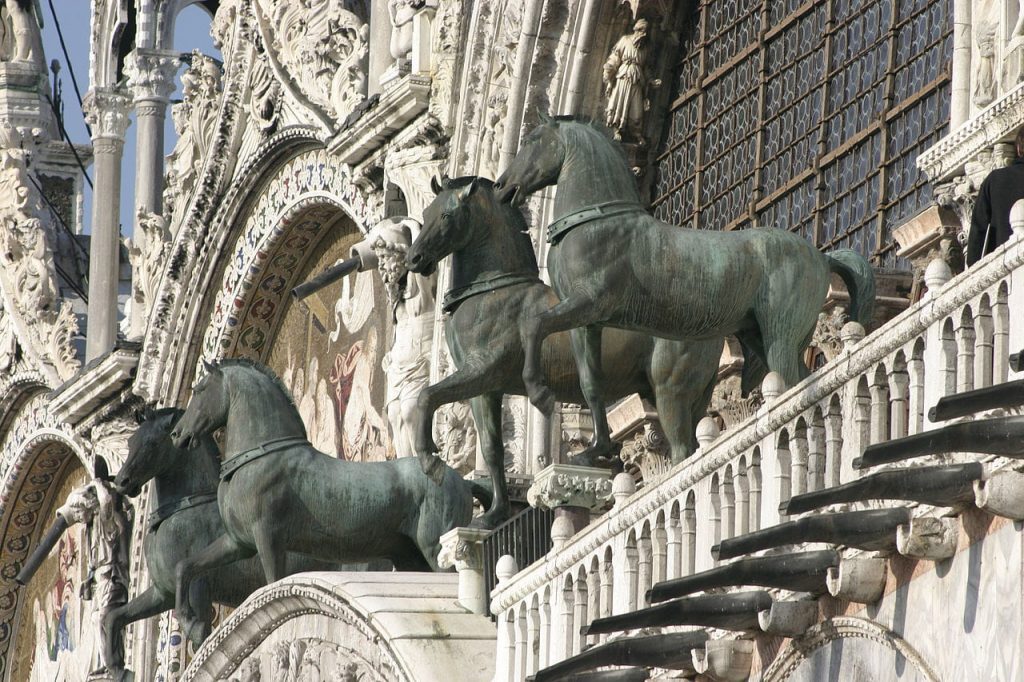One of the works of art valued Venice is the Chariot of Constantinople, decorating the facade of the Basilica of Saint Mark, representing the time in which Venice starred in the Fourth Crusade and the Sack of Constantinople.

Part of its great beauty, the Basilica of San marco saves one of the works of art more interesting, and also more travellers of the World, in addition to having a huge artistic value, economic and symbolic, we are talking about The Chariot of Constantinople. This curious work of art has toured Europe, from Constantinople to Venice, and with a short period of time in Paris.
The Chariot was exposed from the ancient times, in the Hippodrome of Constantinople, until, in 1204 took place The Sack of Constantinople as a result of the Fourth Crusade. The Crusades were the struggles that started by the christians against the muslims for control of the territories of the Near and Middle East, and especially the city of Jerusalem, conquered in the year 638 by the muslims. The papacy could not allow that the territories that make up the "Holy Land" were in muslim hands by launching a series of raids in the territories with the clear goal of returning Jerusalem to the christian side. The crusaders were warriors christians, in many cases, noblemen, that risking losing their lives to defend christianity, the catholic church would be compensated indultando all the sins that you commit or had committed. The First Crusade achieved its goal, and Jerusalem was retaken by the christians; in the Second Crusade tried to recover the County of Edessa but not met the goal, although it managed to keep Jerusalem in christian hands; in 1187 the Sultan of Egypt, Saladin conquered again to Jerusalem and began the Third Crusade with the intention to get it back but failing miserably. This failure did that years later, Pope Innocent III to feel the desire to establish the authority of the Holy see in the christian states of the East and thus join forces to recover Jerusalem, marking the start of the Fourth Crusade between 1202 and 1204. In these moments, the Republic of Venice is the first maritime power in the Eastern Mediterranean with major commercial interests in Constantinople. This will make that Innocent III was put in contact with the Doge of venice Enrico Dandolo to hire a fleet of venetian and in this way to reach the Holy Land, which will not occur because this crusade ended up being more of a struggle between christians of the West against the Christians of the East, reaching the first to plunder some territories of the Christian East, the most important being the Sack of Constantinople (1204), in which crossed the French and venetians were raped women, killed children and stole all the treasures worshipped by the byzantines for later placed in the Holy Chapel of Paris and the Basilica of San marco in Venice. Within these treasures dispossessed was the Chariot of Constantinople, to whom Enrico Dandolo commanded placed on the main facade of the Basilica of San marco.
However, the chariot will not remain eternally in the Basilica since in 1797, Napoleon Bonaparte occupies Venice and ends always with the Republic and the independence of the venetian, it will be him who will take to the force of the chariot and carried to Paris to arrange it on the Arch of the Carousel. Finally in 1815 the Chariot is returned to Venice thanks to the sculptor venetian Antonio Canova, sculptor camera of Napoleon, and in 1980 he made a copy for you to arrange it in the façade, thus protecting the chariot original, which is currently located in the interior of the Basilica.
The sculpture in question belongs to the classical antiquity and is attributed to the sculptor Greek Lysippos in the fourth century a. C. Although it is known as "The Bronze Horses," the work is done in 98% of copper, so as to achieve a gold effect. Currently we can find in Europe several replicas of this sculpture as in the above-mentioned Arc of Carrusell of Paris, the Brandenburg Gate of Berlin, where the chariot is pulled by Victoria, the roman goddess of victory, or in the Arch of the Victory of Madrid, in this case, Minerva Greek goddess of the arts, wisdom and technique of war who drives the chariot of four horses.